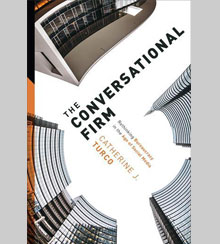strategy+business, Winter 2016
by Theodore Kinni
It’s satisfying when corporate wrongdoing comes complete with a villain, preferably someone larger than life and twice as mean. Having an evil mastermind à la Bernie Madoff to pin things on sets up a happy ending. The bad guy or gal is brought to justice and, voilà, all is right in the business world.
Unfortunately, we are often denied that satisfaction. Some organizational disasters — such as the Deepwater Horizon oil spill and Dieselgate — seem to occur as a result of unintentional internal combustion. Scapegoats always seem to be found, but it’s a stretch to argue that there was a black-mustachioed villain who put match to fuse. Instead, when the investigations are over, the real culprit turns out to be a hodgepodge of systems, processes, or managerial decisions that didn’t raise alarms until the consequences suddenly exploded.
This year’s three best business books on management offer compelling and useful advice on how to avoid such problems. In Pre-Suasion, the best of the group, Robert Cialdini explains how managers can be predisposed to make constructive decisions and can predispose others to take constructive action. In Managing in the Gray, Joseph L. Badaracco shows how managers can make difficult decisions in a more responsible manner. And in The Process Matters, Joel Brockner explores how the decisions that managers make when constructing processes can help prevent undesirable outcomes. Read the rest here.
Monday, October 31, 2016
Best Business Books 2016: Management
Posted by
Theodore Kinni
at
4:50 PM
0
comments
![]()
Labels: bizbook review, books, change management, corporate life, corporate success, decision making, ethics, human resources, leadership, management, personal success, strategy+business
Monday, October 24, 2016
TechSavvy: Competing for Talent in the Platform Economy
 MIT Sloan Management Review, October 24, 2016
MIT Sloan Management Review, October 24, 2016
by Theodore Kinni
Platforms are all the rage these days. Companies are being urged to create their own — à la Uber and Airbnb. But platform advocates often take one thing for granted: a seemingly infinite supply of workers who will happily do the platform operator’s bidding in return for, well, whatever the operator is willing to give them.
That may not be a sound assumption, especially as the competition heats up in platform markets that prove viable. Witness Sheelah Kolhatkar’s article on Uber’s fast-growing rival, Juno, in The New Yorker. “Juno’s business model is to take what Uber has created and appropriate it,” writes Kolhatkar. “Most of what Juno does is predicated on the fact that many drivers feel mistreated by Uber. … If Uber seems cold and impersonal, Juno will smother its drivers with attention. If Uber has raised its commission — the part of each fare that the company keeps — Juno will set a much lower one.”
As the folks at Uber think about how to frame a response to the wooing away of its drivers, they might want to read the new report on platform workers from the Institute for the Future. The IFTF did an ethnographic study of a select group of platform workers. It found the workers fit into seven distinct archetypes and that there are seven qualities that define the platform working experience.
The study also found out what platform workers care about. Their top three concerns: income potential; control over choosing which jobs to take; and work frequency, immediacy of payment, and convenience.
Uber isn’t the only company that should be reading the IFTF report. Its battle for drivers suggests that eventually all successful platform companies will have to compete for contract workers. So they better get to know them. Read the rest here.
Posted by
Theodore Kinni
at
4:20 PM
0
comments
![]()
Labels: AI, articles to ponder, corporate life, corporate success, entrepreneurship, human resources, leadership, management, org culture, TechSavvy, work
Thursday, October 20, 2016
TechSavvy: Beware the Paradox of Automation
 MIT Sloan Management Review, October 20, 2016
MIT Sloan Management Review, October 20, 2016
by Theodore Kinni
Earlier this year, Facebook exorcised those pesky human editors who were introducing political bias into its Trending news list and left the job to algorithms. Now, reports Caitlin Dewey in The Washington Post, the Trending news isn’t biased, but some of it is fake. Turns out the algorithms can’t tell a real news story from a hoax.
Facebook says it can improve its algorithms, but errors of judgment aren’t the only pitfall in transferring human tasks to machines. There’s also the paradox of automation. “It applies in a wide variety of contexts, from the operators of nuclear power stations to the crews of cruise ships, from the simple fact that we can no longer remember phone numbers because we have them all stored in our mobile phones, to the way we now struggle with mental arithmetic because we are surrounded by electronic calculators,” says Tim Hartford in an excerpt published by The Guardian from his new book, Messy: The Power of Disorder to Transform Our Lives. “The better the automatic systems, the more out-of-practice human operators will be, and the more extreme the situations they will have to face.”
Hartford borrows William Langewiesche’s harrowing description of the crash of Air France Flight 447 to illustrate three problems with automation: “First, automatic systems accommodate incompetence by being easy to operate and by automatically correcting mistakes. … Second, even if operators are expert, automatic systems erode their skills by removing the need for practice. Third, automatic systems tend to fail either in unusual situations or in ways that produce unusual situations, requiring a particularly skillful response.”
The excerpt is worth a read — especially if it prompts you to ask if your company’s automation initiatives might entail similar risks. Read the rest here.
Posted by
Theodore Kinni
at
5:03 PM
0
comments
![]()
Labels: articles to ponder, artificial intelligence, books, corporate success, cybersecurity, ethics, management, technology, TechSavvy, work
Wednesday, October 19, 2016
Can Conversation Supplant Bureaucracy?
strategy+business, October 19, 2016
by Theodore Kinni
 In 2012, Catherine Turco became increasingly intrigued by what she saw as a corporate preoccupation with openness. The open communication, decision processes, innovation, and offices in Web 2.0 companies like Facebook and Google were on their way to becoming corporate memes. And stalwarts like IBM and GE were making well-publicized forays into wikis and crowd-sourced product development. In particular, the associate professor of organizational studies at the MIT Sloan School of Management was struck by the gospel of “radical openness” being fervently preached by the leaders of a fast-growing, 600-employee social media firm, which she identifies only as TechCo.
In 2012, Catherine Turco became increasingly intrigued by what she saw as a corporate preoccupation with openness. The open communication, decision processes, innovation, and offices in Web 2.0 companies like Facebook and Google were on their way to becoming corporate memes. And stalwarts like IBM and GE were making well-publicized forays into wikis and crowd-sourced product development. In particular, the associate professor of organizational studies at the MIT Sloan School of Management was struck by the gospel of “radical openness” being fervently preached by the leaders of a fast-growing, 600-employee social media firm, which she identifies only as TechCo.“‘Could this work?’ I wondered,” recalls Turco. “Maybe it was all talk — a savvy presentation of corporate self that masked the same bureaucratic and hierarchical practices firms have had for years. Then again, maybe it would carry lessons for how corporations really could change. One December morning I woke up and decided I had to study TechCo.”
Turco devoted 10 months to that study, spending four days per week at the company; conducting nearly 100 interviews with 77 employees, including the senior leadership team; shadowing and socializing with employees; and attending innumerable meetings during and after work hours, as well as the week-long new employee training program. The welcome result of her immersion into all things TechCo is The Conversational Firm: Rethinking Bureaucracy in the Age of Social Media (Columbia University Press, 2016). This well-written, insightful ethnographic study solidly establishes the notion that hierarchical command-and-control structures and distributed decision-making structures (like holacracy) are not the only choices for managing a company. Read the rest here.
Posted by
Theodore Kinni
at
4:33 PM
0
comments
![]()
Labels: bizbook review, corporate life, corporate success, decision making, human resources, management, org culture, strategy+business, work
Thursday, October 13, 2016
TechSavvy: Why Digitization Won’t Put Operations Managers Out of Work
MIT Sloan Management Review, October 13, 2016
by Theodore Kinni
But perhaps not fewer management jobs. “Even as organizations balance lower investment in traditional operations against greater investment in digital, the need for operations management will hardly disappear,” write McKinsey consultants Albert Bollard, Alex Singla, Rohit Sood, and Jasper van Ouwerkerk in a new article in McKinsey Quarterly. “In fact, we believe the need will be more profound than ever.”
In the near term, the challenge will be the ability of companies “to embrace digital innovation and operations-management discipline at the same time.” That, the authors say, will require figuring out how to combine digital and human resources, modify employee roles to showcase and sustain digitization, support customers as they figure out how to work with the organization, and develop leaders and managers with “much stronger day-to-day skills in working with their teams.” Read the rest here.
Posted by
Theodore Kinni
at
1:55 PM
0
comments
![]()
Labels: AI, articles to ponder, robotics, technology, TechSavvy, virtual reality
Wednesday, October 12, 2016
Nilofer Merchant’s Required Reading
strategy+business, October 12, 2016
by Theodore Kinni
Nilofer Merchant knows something about value creation. By her reckoning, she has had a hand in launching more than 100 products that have netted a combined US$18 billion in sales — first in stints at Apple and Autodesk, and later as an advisor to technology companies such as Logitech, Symantec, and HP.
Rather than focusing on processes and tools, Merchant sees the humanist values of diversity, inclusivity, and collaboration as the keys to creating corporate value. “It’s not that everyone will but that anyone can contribute,” she says.
Her two books reiterate the message. In The New How: Creating Business Solutions through Collaborative Strategy (O’Reilly Media, 2010), Merchant traces the difficulties that many companies encounter in executing strategy to the conventional top-down approach to strategy formulation. She argues for a more inclusive approach to strategy-making that enlists the people responsible for executing it. In 11 Rules for Creating Value in the #SocialEra (Harvard Business Press, 2012), Merchant contends that social technologies and tools have given rise to a new era in which the basis for value creation is collaboration and co-creation by communities of people who are united by an aspirational purpose.
I asked Merchant for a short list of the best reads on value creation. She called out the following three books and a seminal article on organizational learning. Read the rest here.
Posted by
Theodore Kinni
at
4:52 PM
0
comments
![]()
Labels: corporate life, corporate success, entrepreneurship, human resources, innovation, leadership, management, personal success, Required Reading, strategy+business
Thursday, October 6, 2016
Tech Savvy: Hacking Your Work-Life Balance
MIT Sloan Management Review, October 6, 2016
by Theodore Kinni
When I read CEO memoirs, I always keep an eye out for insights into how people in demanding positions maintain a healthy work-life balance. But when the topic is addressed at all, it’s usually in a dismal admission that life — mainly family life — got the short end of the stick. Happily, Michal Lev-Ram’s Fortune profile of Qualtrics CEO Ryan Smith suggests there might be a better way.
Smith has his hands full. The Provo, Utah-based online survey company he helped co-found in 2002 has 1,200 employees and a valuation of more than $1 billion. He and wife Ashley, who has a business of her own, have five kids ranging from 4 months to 8 years old. But he says he keeps it all together by “hacking the integration” of life and work. That means tracking both work and family time.
“Smith continually uses data to inform and guide the way he allocates his time,” explains Lev-Ram. “With the aid of an executive assistant who’s a former statistician, Smith tracks everything from the number of hours he devotes to interviews to how much one-on-one time he spends with each of his children. Ask him how many nights he spent away from home last year, and all he has to do is consult a spreadsheet.” Quarterly, the CEO reviews a colored-coded spreadsheet that summarizes how he spent his time, and then sets new goals and rules for work and life.
Who knows? If Smith keeps it up for another 20 years or so, maybe his CEO memoir won’t be quite as dismal as all the others. Read the rest here.
Posted by
Theodore Kinni
at
5:00 PM
0
comments
![]()
Labels: corporate success, IoT, personal success, technology, TechSavvy, work














